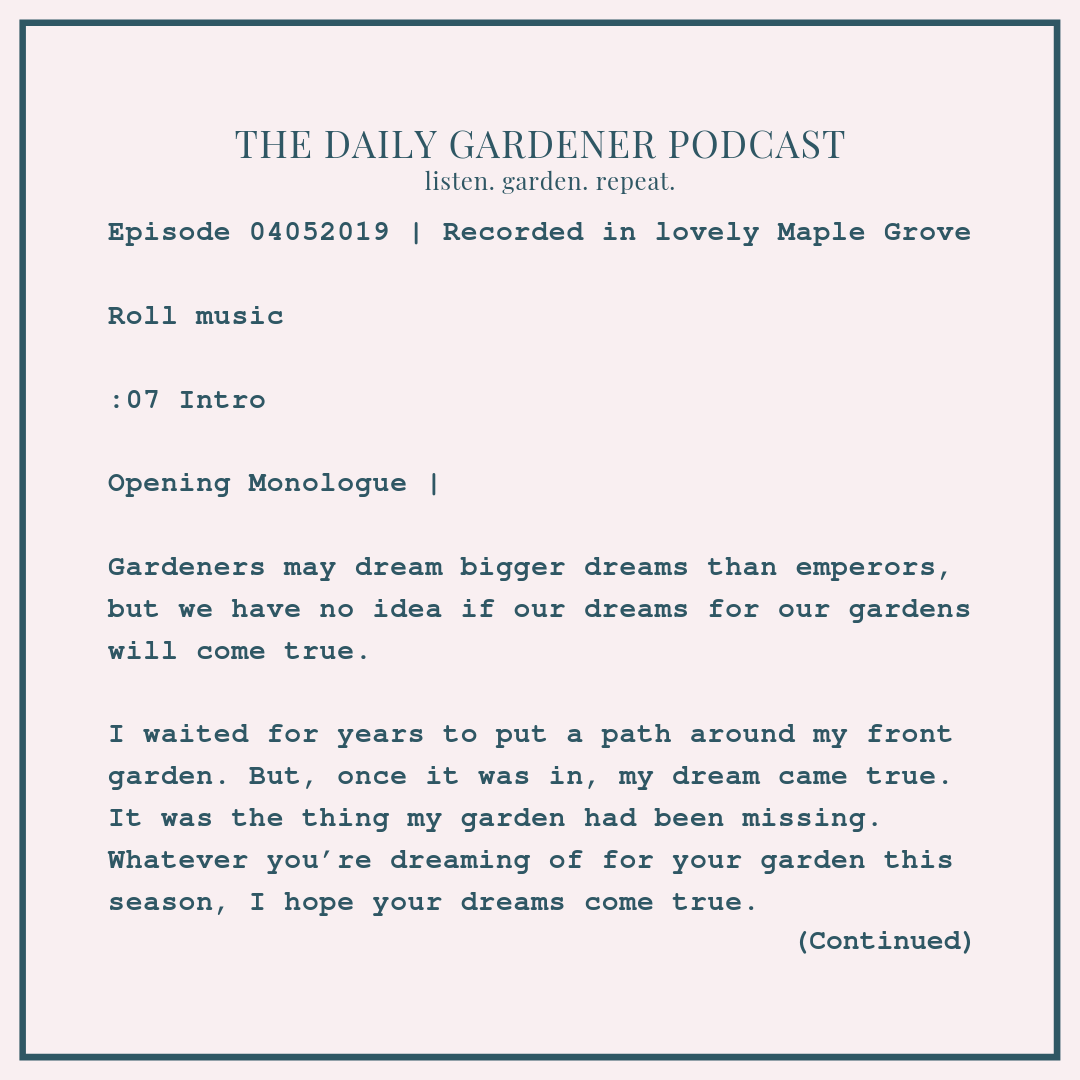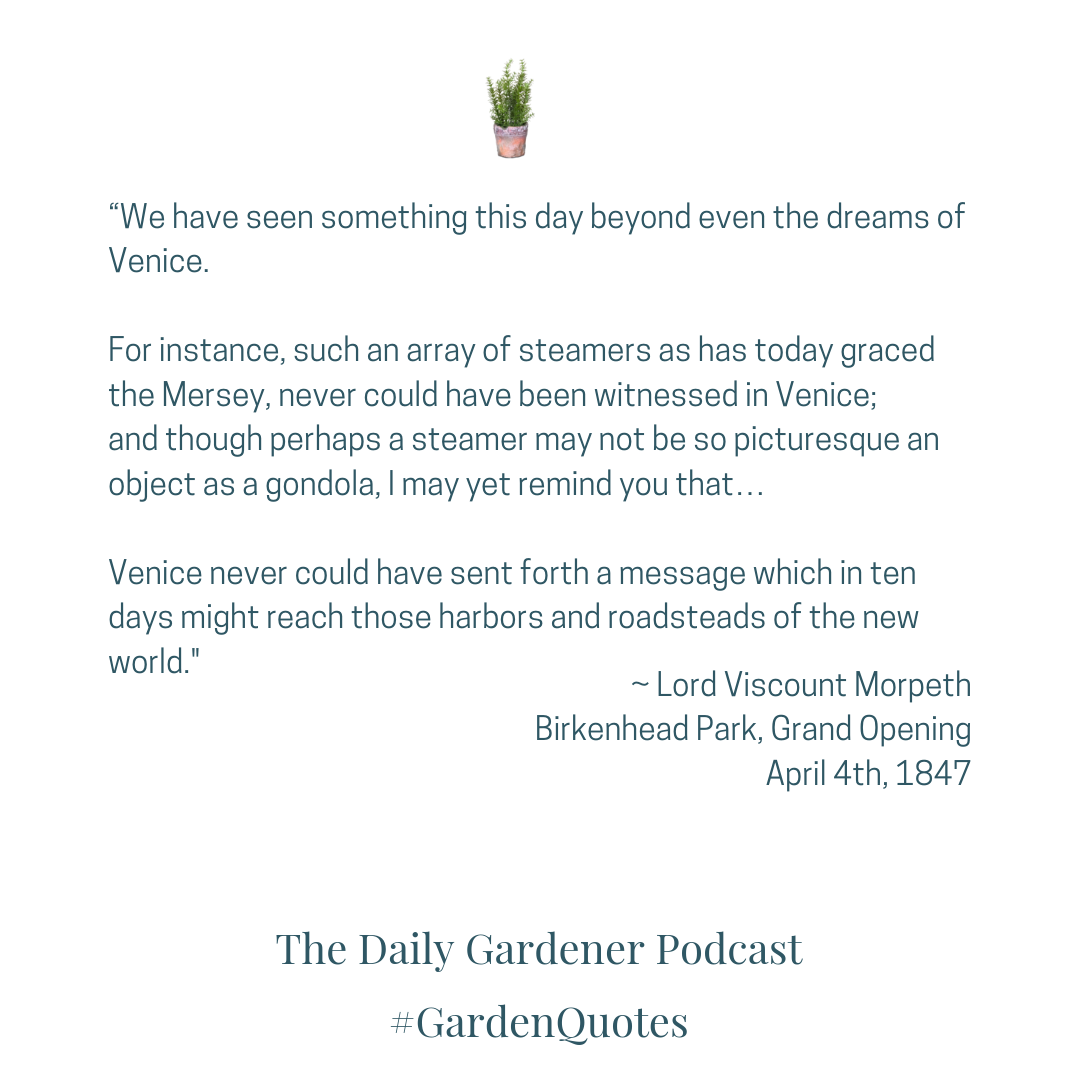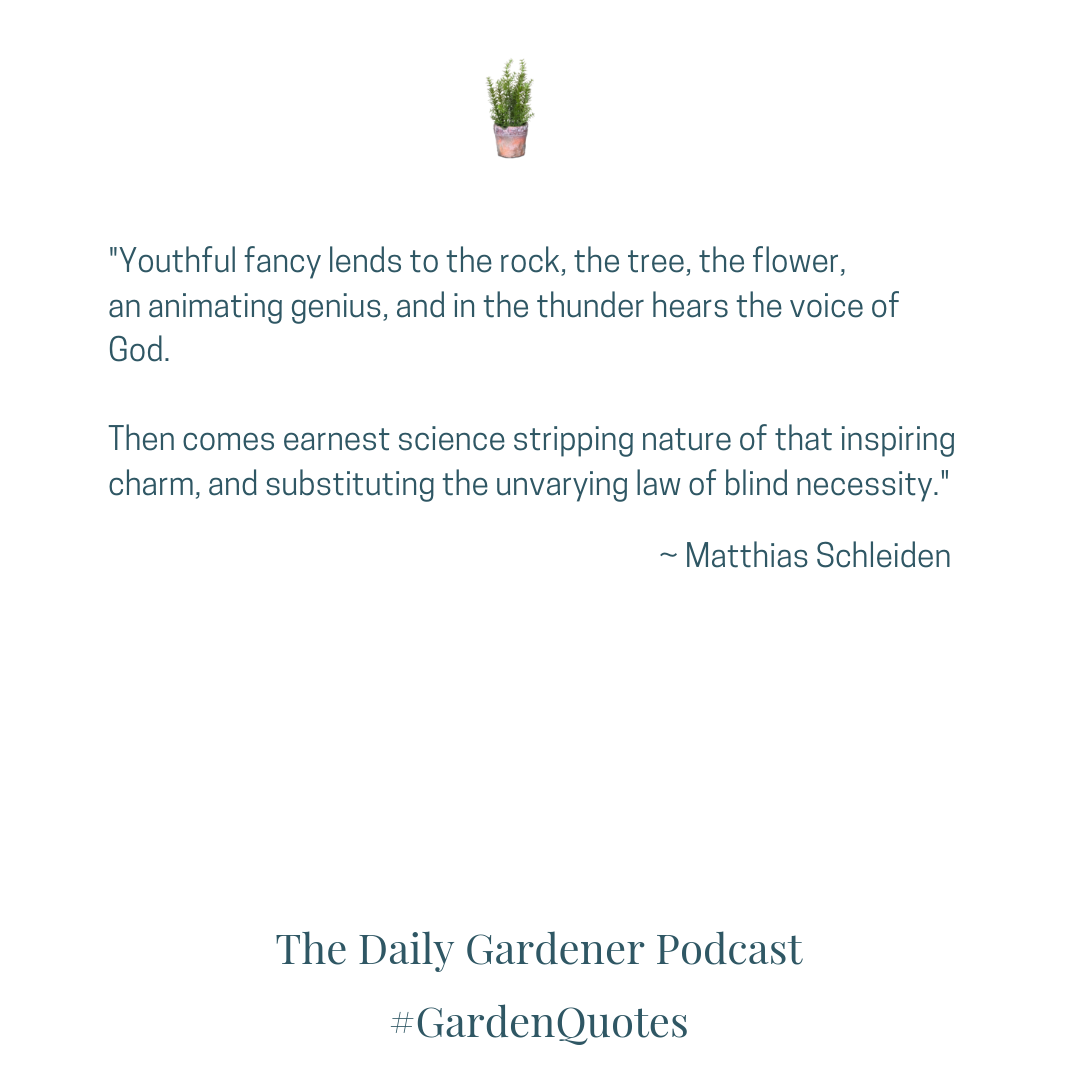October 24, 2019 An 11-Story Monarch Mural, What Landscape Architects Wish You Knew, Antonie van Leeuwenhoek, Marianne North, Margaret Owen, Emily Dickinson, The Daylily by Peat and Petit, Plants to Cut Back, and A Fancy from Fontanelle
Today we celebrate the scientist who set the stage for Plant Anatomy and the amazing botanical illustrator Marianne North who traveled the world, capturing exotic flowers with her magnificent oil paintings.
We also celebrate Margaret Owen, the English galanthophile and gardener we lost five years ago today.
We'll hear some thoughts from Emily Dickinson about Autumn - it's her Nature 27 poem - with the famous line "I'll put a trinket on."
We'll Grow That Garden Library with today's book The Daylily by John P. Peat and Ted L. Petit
I'll talk about the perennials you can cut back right now and then wrap things up with a sweet story about the rose poem that went viral in 1885.
But first, let's catch up on a few recent events.
Ink Dwell selected a location at 455 Hyde St in San Francisco as the site of their next Monarch Mural. The 44-unit, 11-story apartment building was due for a new paint job anyway, so it was the perfect canvas for the project.
Imagine an 11-story mural dedicated to the monarch!
Ink Dwell has installed similar murals at eight other locations across the country to raise awareness about the declining monarch butterfly population. The project on Hyde street will be the largest installation - covering three sides of the building, and Ink Dwell hopes the mural makes Monarch butterflies "impossible to ignore."
Ink Dwell and its conservation partner, the Xerces Society, work with communities to provide information and educational materials about the butterflies’ migration, and the current population declines for pollinators.
I'll share 3 of my favorites from this list right now:
First, your children will quickly outgrow your space.
In the piece, landscape architect Kate Stickle y says:
“Your children will outgrow, out-throw, and out-kick your small lawn long before you finish creating your garden, so don’t plan your space around them.” She suggests that while your kids are young, let them blow off steam in the neighborhood park. Meanwhile, plan an outdoor space for your future teenagers and their friends—one that feels private (but is still within the property lines)."
Second, gravel can’t replace the mulch.
Some folks prefer gravel because it stays in place. But, gravel offers nothing nutrient-wise for the soil.
Landscape Architects Gretchen Whittier and Kate Stickley suggest "planting ground cover near walkways and giving it time to spread out. You may still need mulch, but perhaps only for one season."
Third, a specimen tree won’t live forever.
"Designing and building your new house around a beautiful specimen tree isn’t always the best course of action. Before even starting the design process, consult an arborist to find out the tree’s health and longevity."
Now, if you'd like to check out these curated articles for yourself, you're in luck - because I share all of it with the Listener Community in the Free Facebook Group - The Daily Gardener Community. So there’s no need to take notes or track down links - just head on over to the group - and join.
Brevities
#OTD Today, in 1632, the "father of microbiology" Antonie van Leeuwenhoek was born.
Leeuwenhoek's interest in making lenses led to his discovery of microbial life. Leeuwenhoek's work set the stage for plant anatomy.
#OTD Today is the birthday of the intrepid traveler and botanical artist Marianne North who was born on this day in 1830.
Marianne's father was friends with Darwin and Sir Joseph Dalton Hooker, who was the director of the Royal Botanic Gardens, Kew.
When she was 25 years old, Marianne's mother died, and she turned to flower painting as a way to cope with her grief. Fifteen years later, right before she became forty, Marianne's father died. By this point, Marianne was an experienced traveler and painter. She had means and autonomy. Marianne decided to spend the rest of her life traveling the globe to find and paint the exotic flowers of the world.
Among her many excursions, Marianne spent a year living in a hut and painting the flowers of the Brazilian forest. She painted the giant redwood trees of California and was heartbroken at their destruction.
It was Marianne North who said,
"It broke one's heart to think of man, the civilizer, wasting treasures in a few years to which savages and animals had done no harm for centuries."
In September 1880, based on the recommendation of her father's great friend Charles Darwin, Marianne visited Australia. As for Marianne, she referred to Darwin as "The greatest man living." Darwin specifically suggested Australia for Marianne because flora and fauna down under were less known and more unique.
Marianne traveled by coach between Brisbane and Sydney, painting at every stop when she lamented, "they never stop where the flowers are!" To make matters worse, the brevity of the overnight stops meant her oil paintings didn't have time to dry completely.
During her visit, Marianne painted a tree that would become known as The Marianne North tree. It was a twisted Karri tree located near Pemberton.
Marianne single-handedly created over 1,000 pieces of flower art. She became a renowned botanical illustrator with several plant species named in her honor; her body of work has been on permanent display at Kew Gardens since 1882.
If you can imagine a gallery of rooms with walls plastered with pieces of art about the size of an 8.5 x 11 sheet of paper, you can envision the impact of standing in the Marianne North Gallery. The 832 paintings represent 20 years of travel over five continents and 17 countries, capturing the scenery and flora in vibrant oil color. The North Gallery was paid for by an endowment from Marianne North.
In 2016, the BBC aired a documentary about Marianne North called Kew's Forgotten Queen.
#OTD Today is the fifth anniversary of the death of Margaret Owen, who died on this day in 2014.
Owen was an English farmer and gardener.
When she was twenty, Margaret married Godfrey Owen (he had proposed to her in a cattle shed). On their family farm, they raised four children together. They were together for 33 years.
But, when Margaret was 53 years old, Godfrey died from a brain tumor. Margaret decided to move out of the farmhouse, and she gave the farm to their son. But she had the idea of keeping an acre of land for herself to create a garden she called "the Patch."
With her focus on gardening, Margaret found herself drawn to snowdrops, and she became a galanthophile (an expert on snowdrops).
Margaret herself discovered many stunning snowdrops. She named one of the most striking after her husband - calling it the 'Godfrey Owen.' The Godfrey Owen snowdrop is a stunner. It's a double-flowered snowdrop with six outer petals and six inner segments. (Most snowdrops have just three exterior and three inner petals). Margaret also named other plants in honor of her husband. She named an Iris, a Bergenia, and a Guernsey Lily species Godfrey Owen as well.
As a plantswoman extraordinaire, Margaret is remembered by many for her "snowdrop parties" which took place on the last Saturday in February. Margaret happily hosted a who's who of English horticulture.
The day after the party, Margaret would dig up her snowdrops in the Patch and sell them to her guests and visitors. Then, she donated all the proceeds to the Multiple Sclerosis Society in honor of her sister.
Unearthed Words
"The morns are meeker than they were,
The nuts are getting brown;
The berry's cheek is plumper,
The rose is out of town.
The maple wears a gayer scarf,
The field a scarlet gown.
Lest I should be old-fashioned,
I'll put a trinket on."
- Emily Dickinson, Nature 27 - Autumn
Today's Grow That Garden Library book recommendation: The Daylily by John P. Peat and Ted L. Petit
Daylilies are tough, carefree beauties. They can survive the tropical heat of a Florida garden and the bitter cold of a northern garden. And, daylilies are some of the easiest plants to hybridize. For close to 100 years, Gardeners have been hybridizing their most desirable features in an attempt to create new, more evolved daylilies.
Peat and Petit were inspired by Bill Munson Jr.'s classic book on Hemerocallis or the daylily. They review the history of the daylily and share many of the hybrids along with excellent advice for growing, featuring chapters from some of the top daylily authorities from around the world.
I love what they mentioned in the preface of their book about gardeners who join daylily clubs and societies. They said that gardeners "come for the flower but stay for the people."
Today's Garden Chore
Plants That Should Be Cut Back In The Fall:
Hostas
Yarrow
Peonies
Coreopsis
Bee Balm
Daylilies
Iris
Something Sweet
Reviving the little botanic spark in your heart
It was on this day in 1885 that a little poem about a rose by the English poet Henry Austin Dobson appeared in the Leicester Chronicle in England.
It was an instant hit and picked up by newspapers around the world.
I spent a bit of time piecing together various remnants about the poem online, and I cobbled together a little backstory along with my analysis about this charming piece to help you understand it.
Dobson's poem is titled A Fancy from Fontenelle, and it has a long French subtitle, which means "as fas as any rose could remember, no gardener had ever died."
The French philosopher and writer Diderot inspired Dobson.
In 1769, Diderot wrote a story about something called the Fallacy of the Ephemeral. One of the main characters in the story is named Fontenelle. The Fallacy of the Ephemeral alludes to the false belief held by Fontenelle's garden roses that their gardener is immortal. The roses emerge in the spring; they thrive in the summer and go dormant as fall changes to winter. Through every season, the gardener is always there tending to them. In other words, no rose [has ever lived long enough] to remember the death of the gardener.
Along those lines, Dobson's poem is also told from the perspective of the rose. In this case, the rose is vain and self-assured; she incorrectly assumes that she will outlive the old gardener that tends her. Dobson's message reinforces the Fallacy of the Ephemeral. The simple truth is revealed at the end of the poem: beauty fades and time marches on.
THE ROSE in the garden slipped her bud,
And she laughed in the pride of her youthful blood,
As she thought of the Gardener standing by —
“He is old — so old! And he soon must die!”The full Rose waxed in the warm June air,
And she spread and spread till her heart lay bare;
And she laughed once more as she heard his tread —
“He is older now! He will soon be dead!”But the breeze of the morning blew and found
That the leaves of the blown Rose strewed the ground;
And he came at noon, that Gardener old,
And he raked them gently under the mold.And I wove the thing to a random rhyme:
For the Rose is Beauty; the Gardener, Time.
Thanks for listening to the daily gardener,
and remember:
"For a happy, healthy life, garden every day."
What Listeners Say
KIND WORDS FROM LOVELY LISTENERS
"I just discovered you!
I googled garden podcasts and
I'm so glad I found the show.
I start every day with The Daily Gardener!"
"I love gardening.
I been gardening for over 40 years.
A friend got me started on listening to gardening podcasts and yours just popped up.
I am all the richer for it!"
"I've been a Still Growing podcast listener for years.
You are so welcoming and your voice is so soothing!
I love The Daily Gardener because it's different. I can't imagine how much work it is to make a show like this but I thank you for it."
SI HORTUM IN HORTORIA PODCASTA IN BIBLIOTEHCA HABES, NIHIL DEERIT.













